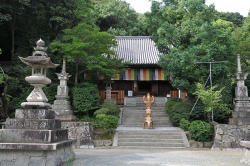Difference between revisions of "Ishite-ji"
Jump to navigation
Jump to search
(Created page with "'''Ishite-ji''' (石手寺?) is a Shingon temple in Matsuyama, Ehime Prefecture, Japan. It is Temple 51 on the Shikoku 88 temple pilgrimage. Seven of its structures have been ...") |
|||
| Line 1: | Line 1: | ||
| − | '''Ishite-ji''' (石手寺?) is a Shingon temple in Matsuyama, Ehime Prefecture, Japan. It is Temple 51 on the Shikoku 88 temple pilgrimage. Seven of its structures have been designated National Treasures or Important Cultural Properties. | + | '''Ishite-ji''' (石手寺?) is a [[Shingon]] [[temple]] in Matsuyama, Ehime Prefecture, [[Japan]]. It is [[Temple]] 51 on the {{Wiki|Shikoku}} 88 [[temple]] [[pilgrimage]]. Seven of its structures have been designated National [[Treasures]] or Important {{Wiki|Cultural}} Properties. |
==History== | ==History== | ||
[[File:Ishiteji_05.JPG|thumb|250px|]] | [[File:Ishiteji_05.JPG|thumb|250px|]] | ||
| − | The temple of Annoyō-ji was originally founded by Gyōki, and converted from a Hossō to a Shingon temple by Kūkai. Rebuilt by the ruler of Iyo Province in the eighth century, many of the temple buildings were destroyed by the Chōsokabe in the sixteenth century. The aetiology sees the temple's name changed to Ishite-ji or 'stone-hand temple' after the tightly-clenched hand of the newborn son of the lord of Iyo Province was opened by a priest from the Annoyō-ji to reveal a stone inscribed 'Emon Saburō is reborn'. | + | The [[temple]] of Annoyō-ji was originally founded by [[Gyōki]], and converted from a [[Hossō]] to a [[Shingon]] [[temple]] by [[Kūkai]]. Rebuilt by the [[ruler]] of Iyo Province in the eighth century, many of the [[temple]] buildings were destroyed by the Chōsokabe in the sixteenth century. The aetiology sees the temple's [[name]] changed to Ishite-ji or 'stone-hand [[temple]]' after the tightly-clenched hand of the newborn son of the [[lord]] of Iyo Province was opened by a [[priest]] from the Annoyō-ji to reveal a stone inscribed '[[Emon]] Saburō is [[reborn]]'. |
==Buildings== | ==Buildings== | ||
| − | ::*Niōmon (二王門?) (1318) (National Treasure) | + | ::*Niōmon (二王門?) (1318) ({{Wiki|National Treasure}}) |
| − | ::*Three-storey pagoda (三重塔?) (late Kamakura period) (Important Cultural Property) | + | ::*Three-storey [[pagoda]] (三重塔?) (late [[Kamakura period]]) (Important {{Wiki|Cultural}} Property) |
| − | ::*Hondō (本堂?) (late Kamakura period) (ICP) | + | ::*[[Hondō]] ([[本堂]]?) (late [[Kamakura period]]) (ICP) |
| − | ::*Kariteimotendō (訶梨帝母天堂?) (late Kamakura period) (ICP) | + | ::*Kariteimotendō (訶梨帝母天堂?) (late [[Kamakura period]]) (ICP) |
::*Shōrō (鐘楼?) (1333) (ICP) | ::*Shōrō (鐘楼?) (1333) (ICP) | ||
::*Gomadō (護摩堂?) (Nanboku-chō period) (ICP) | ::*Gomadō (護摩堂?) (Nanboku-chō period) (ICP) | ||
| − | ==Treasures== | + | ==[[Treasures]]== |
| − | ::*Gorintō (五輪塔?) (late Kamakura Period) (Important Cultural Property) | + | ::*[[Gorintō]] (五輪塔?) (late [[Kamakura Period]]) (Important {{Wiki|Cultural}} Property) |
| − | ::*Bronze bell (銅鐘?) (1251) (ICP) | + | ::*Bronze [[bell]] (銅鐘?) (1251) (ICP) |
| − | ::*Inscription of 1567 telling the legend of Emon Saburō | + | ::*Inscription of 1567 telling the legend of [[Emon]] Saburō |
::*Casket housing the eponymous stone. | ::*Casket housing the eponymous stone. | ||
{{W}} | {{W}} | ||
[[Category:Buddhist Pilgrimages]] | [[Category:Buddhist Pilgrimages]] | ||
Latest revision as of 22:09, 13 June 2014
Ishite-ji (石手寺?) is a Shingon temple in Matsuyama, Ehime Prefecture, Japan. It is Temple 51 on the Shikoku 88 temple pilgrimage. Seven of its structures have been designated National Treasures or Important Cultural Properties.
History
The temple of Annoyō-ji was originally founded by Gyōki, and converted from a Hossō to a Shingon temple by Kūkai. Rebuilt by the ruler of Iyo Province in the eighth century, many of the temple buildings were destroyed by the Chōsokabe in the sixteenth century. The aetiology sees the temple's name changed to Ishite-ji or 'stone-hand temple' after the tightly-clenched hand of the newborn son of the lord of Iyo Province was opened by a priest from the Annoyō-ji to reveal a stone inscribed 'Emon Saburō is reborn'.
Buildings
- Niōmon (二王門?) (1318) (National Treasure)
- Three-storey pagoda (三重塔?) (late Kamakura period) (Important Cultural Property)
- Hondō (本堂?) (late Kamakura period) (ICP)
- Kariteimotendō (訶梨帝母天堂?) (late Kamakura period) (ICP)
- Shōrō (鐘楼?) (1333) (ICP)
- Gomadō (護摩堂?) (Nanboku-chō period) (ICP)
Treasures
- Gorintō (五輪塔?) (late Kamakura Period) (Important Cultural Property)
- Bronze bell (銅鐘?) (1251) (ICP)
- Inscription of 1567 telling the legend of Emon Saburō
- Casket housing the eponymous stone.
